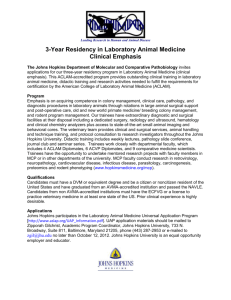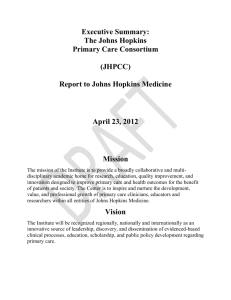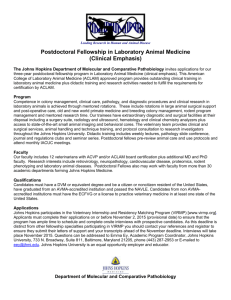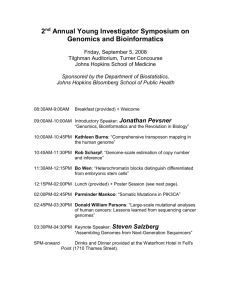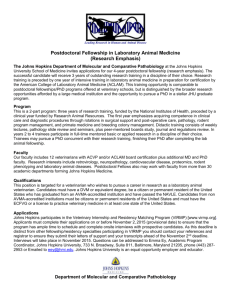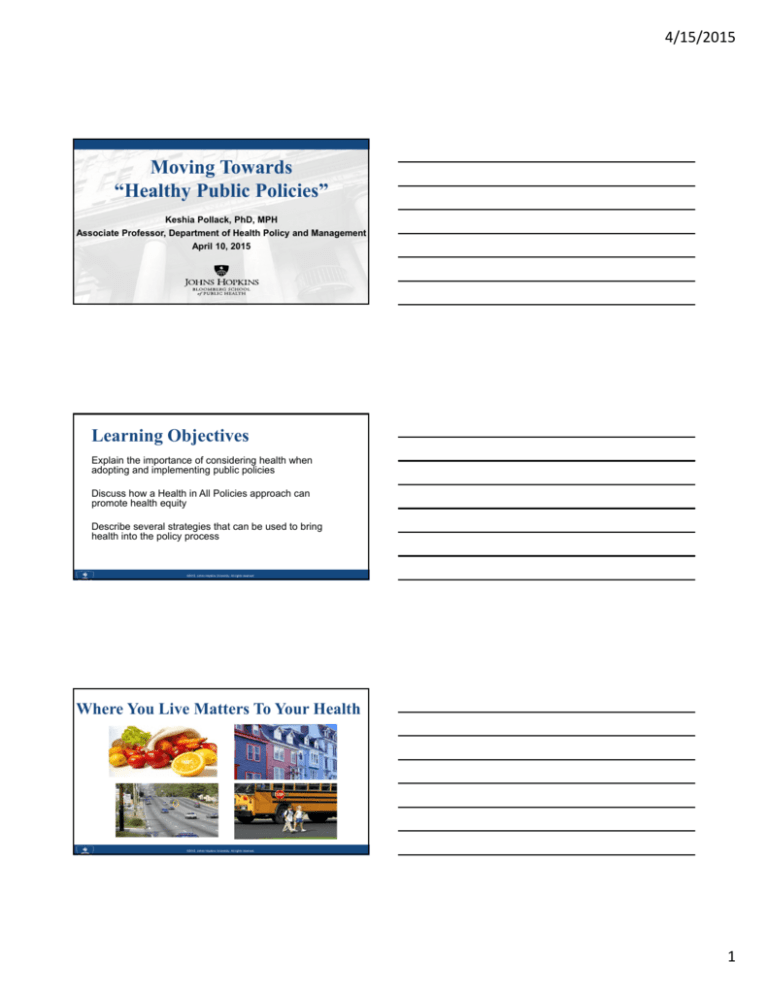
4/15/2015
Moving Towards
“Healthy Public Policies”
Keshia Pollack, PhD, MPH
Associate Professor, Department of Health Policy and Management
April 10, 2015
Learning Objectives
Explain the importance of considering health when
adopting and implementing public policies
Discuss how a Health in All Policies approach can
promote health equity
Describe several strategies that can be used to bring
health into the policy process
© 2014, Johns Hopkins University. All rights reserved.
© 2014,
Johns
Hopkins
University.
All rights
reserved.
© 2014,
Johns
Hopkins
University.
Allrights
rights
reserved.
©2015,
Johns
Hopkins
University.
All
reserved.
Where You Live Matters To Your Health
© 2014, Johns Hopkins University. All rights reserved.
© 2014,
Johns
Hopkins
University.
All rights
reserved.
© 2014,
Johns
Hopkins
University.
Allrights
rights
reserved.
©2015,
Johns
Hopkins
University.
All
reserved.
1
4/15/2015
The Problem
So many daily policy decisions made outside of the
health sector have significant health implications that go
unrecognized and often result in unintended negative
consequences.
© 2014, Johns Hopkins University. All rights reserved.
Image courtesy of Jscreationzs and FreeDigitalPhotos.net.
© 2014,Johns
JohnsHopkins
HopkinsUniversity.
University.All
Allrights
rightsreserved.
reserved.
©2015,
“Root Causes” of Health
Social Determinants of Health Matter
© 2014, Johns Hopkins University. All rights reserved.
World Health Organization, Commission on the Social Determinants of Health (2008)
© 2014,Johns
JohnsHopkins
HopkinsUniversity.
University.All
Allrights
rightsreserved.
reserved.
©2015,
5
Public Health – A Turning Point
“Public health agencies alone cannot assure the
nation’s health”
Institute of Medicine, 2002. The Future of the Public’s
Health in the 21st Century
© 2014, Johns Hopkins University. All rights reserved.
© 2014,Johns
JohnsHopkins
HopkinsUniversity.
University.All
Allrights
rightsreserved.
reserved.
©2015,
2
4/15/2015
Health in All Policies (HiAP)
In recognition that:
– Factors outside the health care system play a
large role in determining one’s health status
– Not all determinants of health can be controlled by
policies within the health sector
© 2014, Johns Hopkins University. All rights reserved.
© 2014,Johns
JohnsHopkins
HopkinsUniversity.
University.All
Allrights
rightsreserved.
reserved.
©2015,
Health in All Policies (HiAP)
An approach to public policies across sectors that
systematically takes into account the health and health
systems implications of decisions, seeks synergies, and
avoids harmful health impacts, in order to improve
population health and health equity.
“Healthy Public Policies” (policy formation, adoption,
implementation)
WHO Consultation and HiAP Framework, 2013
www.healthpromotion2013.org/health-promotion/health-in-all-policies
© 2014, Johns Hopkins University. All rights reserved.
© 2014,Johns
JohnsHopkins
HopkinsUniversity.
University.All
Allrights
rightsreserved.
reserved.
©2015,
HiAP: Two Paths to Achieve the Same Goal
1. Specific initiatives or programs undertaken by
another sector with the express purpose of improving
health (e.g., Baltimore City complete streets policy)
© 2014, Johns Hopkins University. All rights reserved.
© 2014,Johns
JohnsHopkins
HopkinsUniversity.
University.All
Allrights
rightsreserved.
reserved.
©2015,
3
4/15/2015
HiAP: Two Paths to Achieve the Same Goal
2. Integration of considerations about health impacts
into “non-health” decision-making to:
– Maximize positive health impacts
– Minimize unintended negative health
consequences
– Foster intersectoral collaboration
– Ensure different parts of society are not working at
cross-purposes
© 2014, Johns Hopkins University. All rights reserved.
© 2014,Johns
JohnsHopkins
HopkinsUniversity.
University.All
Allrights
rightsreserved.
reserved.
©2015,
Key Elements of HiAP
Engage stakeholders, especially in non-health sectors
Support intersectoral collaboration
Focus on factors that affect where people live, work, play, and
travel
Promote health, equity, and sustainability
Benefit multiple partners
Accountability
© 2014, Johns Hopkins University. All rights reserved.
http://www.who.int/social_determinants/hiap_statement_who_sa_final.pdf
© 2014,
Johns
Hopkins
University.
All rights
reserved.
© 2014,
Johns
Hopkins
University.
Allrights
rights
reserved.
©2015,
Johns
Hopkins
University.
All
reserved.
HiAP in Practice: Internationally
The Adelaide Statement was developed by the participants of
the Health in All Policies International Meeting, Adelaide, South
Australia, 2010
- Emphasizes that government objectives are best achieved
when all sectors include health
Provided valuable input into the World Conference on SDOH in
Brazil 2011, the 8th Global Conference on Health Promotion in
Finland 2013, and preparations for the Millennium Development
Goals (MDGs) post-2015
© 2014, Johns Hopkins University. All rights reserved.
http://www.who.int/social_determinants/hiap_statement_who_sa_final.pdf
© 2014,
Johns
Hopkins
University.
All rights
reserved.
© 2014,
Johns
Hopkins
University.
Allrights
rights
reserved.
©2015,
Johns
Hopkins
University.
All
reserved.
4
4/15/2015
HiAP in Practice: Federal Level
Engage multiple sectors to take actions to “strengthen
policies and improve practices that are driven by the
best available evidence and knowledge.” (Healthy
People 2020)
“Integrate health criteria into decision making across
multiple sectors...identifying and prioritizing actions
across many sectors to reduce the incidence and
burden of the leading causes of death and disability.”
(National Prevention, Health Promotion, and Public
Health Council. 2010 Annual Status Report)
© 2014, Johns Hopkins University. All rights reserved.
© 2014,
Johns
Hopkins
University.
All rights
reserved.
© 2014,
Johns
Hopkins
University.
Allrights
rights
reserved.
©2015,
Johns
Hopkins
University.
All
reserved.
HiAP in Practice: State Level
“California Health in All Policies (HiAP) Task Force aims
to improve health by “improving air and water quality,
protecting natural resources and agricultural lands,
increasing the availability of affordable housing,
improving infrastructure systems, promoting public
health, planning sustainable communities, and meeting
the state’s climate change goals…finding opportunities
to add a health lens in public policy…and increase
collaboration across agencies.”
California Executive Order S-04-10 (Gov Schwarzenegger)
© 2014, Johns Hopkins University. All rights reserved.
© 2014,
Johns
Hopkins
University.
All rights
reserved.
© 2014,
Johns
Hopkins
University.
Allrights
rights
reserved.
©2015,
Johns
Hopkins
University.
All
reserved.
HiAP in Practice: Local Level
Baltimore City Cross Agency Health Taskforce (CAHT)
Representatives from all city agencies that are working
together to promote cross sector efforts supporting
Healthy Baltimore 2015’s ten priority areas
Structured to: identify areas for action; support the
efforts of the agencies; and provide mutual
accountability
Addresses inequities
© 2014, Johns Hopkins University. All rights reserved.
© 2014,
Johns
Hopkins
University.
All rights
reserved.
© 2014,
Johns
Hopkins
University.
Allrights
rights
reserved.
©2015,
Johns
Hopkins
University.
All
reserved.
5
4/15/2015
Lessons Regarding HiAP
Efforts to incorporate health in non-health sectors are
most successful when…
Decision-making processes are transparent
Decision-making is democratic and inclusive
Decision-makers themselves are held accountable for
their actions
© 2014, Johns Hopkins University. All rights reserved.
© 2014,
Johns
Hopkins
University.
All rights
reserved.
© 2014,
Johns
Hopkins
University.
Allrights
rights
reserved.
©2015,
Johns
Hopkins
University.
All
reserved.
Challenges with Advancing HiAP
Little to no common language between sectors
Little to no formalized interactions between health and
other sectors
Funding is often very specific and driven by silos
Chasm: public health tries to be science-driven and
policy and planning is driven by other considerations:
economics, politics, technology, deadlines, votes, etc.
© 2014, Johns Hopkins University. All rights reserved.
© 2014,
Johns
Hopkins
University.
All rights
reserved.
© 2014,
Johns
Hopkins
University.
Allrights
rights
reserved.
©2015,
Johns
Hopkins
University.
All
reserved.
HiAP and Health Equity
Inequities in opportunity → inequities in health
Disparities in health outcomes that emanate from unjust
and unfair differences in social, economic,
environmental, and political conditions
Obstacle to opportunity because of race, income, ability,
geography, age, immigration status, gender, and sexual
orientation, etc.
© 2014, Johns Hopkins University. All rights reserved.
Promoting Equity Through HIA, 2013 © 2014,
Johns
Hopkins
University.
All rights
reserved.
© 2014,
Johns
Hopkins
University.
Allrights
rights
reserved.
©2015,
Johns
Hopkins
University.
All
reserved.
6
4/15/2015
HiAP and Health Equity
Address health inequities: more fair and just distribution
of the social, economic, environmental; social justice
Target the social determinants of health
Engage vulnerable populations in the policy process
© 2014, Johns Hopkins University. All rights reserved.
Promoting Equity Through HIA, 2013 © 2014,
Johns
Hopkins
University.
All rights
reserved.
© 2014,
Johns
Hopkins
University.
Allrights
rights
reserved.
©2015,
Johns
Hopkins
University.
All
reserved.
Some Tools and Tactics to Achieve
HiAP
There is no one single way to “do” health in all policies
Creating cross-sector government structures
Integrating health into planning processes including
zoning updates and General Plans*
© 2014, Johns Hopkins University. All rights reserved.
*From Human Impact Partners Website
© 2014,
Johns
Hopkins
University.
All rights
reserved.
© 2014,
Johns
Hopkins
University.
Allrights
rights
reserved.
©2015,
Johns
Hopkins
University.
All
reserved.
Some Tools and Tactics to Achieve
HiAP
Applying specialized assessment tools (e.g., walkability
surveys) within planning contexts*
Integrating health language into RFPs and developing
health-related grant scoring criteria*
Health Impact Assessment (HIA)
© 2014, Johns Hopkins University. All rights reserved.
*From Human Impact Partners Website
© 2014,
Johns
Hopkins
University.
All rights
reserved.
© 2014,
Johns
Hopkins
University.
Allrights
rights
reserved.
©2015,
Johns
Hopkins
University.
All
reserved.
7
4/15/2015
Defining Health Impact Assessment (HIA)
A structured process that uses scientific data,
professional expertise, and stakeholder input to identify
and evaluate public health consequences of proposals
and suggests actions that could be taken to minimize
adverse health impacts and optimize beneficial ones.
Source: “Improving Health in the United States: The Role of Health
Impact Assessments” by the National Research Council,
September 2011
© 2014, Johns Hopkins University. All rights reserved.
© 2014,
Johns
Hopkins
University.
All rights
reserved.
© 2014,
Johns
Hopkins
University.
Allrights
rights
reserved.
©2015,
Johns
Hopkins
University.
All
reserved.
HIA Addresses Determinants of Health
How does the
proposed
project, plan, policy
Affect
Housing
Air quality
Noise
Safety
Social networks
Nutrition
Parks and natural space
Private goods and services
Public services
Transportation
Livelihood
Water quality
Education
Inequities
and lead to
health
outcomes
Slide courtesy of Human Impact Partners
HIA can be applied to a range of
sectors
8
4/15/2015
HIA Examples
HIA can be applied to a wide range of sectors
• Energy: state legislature’s decision on funding for the Low Income
Housing Energy Assistance Program
• Agriculture: statewide farm-to-school legislation
• Built environment: HIA of the city’s proposed zoning changes
HIA can be applied to policy, project, program
• Policy: Proposed changes to SNAP
• Project: Senior housing redevelopment in California
© 2014, Johns Hopkins University. All rights reserved.
• Program: Zero tolerance program
© 2014,
Johns
Hopkins
University.
All rights
reserved.
© 2014,
Johns
Hopkins
University.
Allrights
rights
reserved.
©2015,
Johns
Hopkins
University.
All
reserved.
HIA…
Provides a framework for community capacity-building and
empowerment
Involves a broad-range of impacted people
Is an effective tool for meaningful cross-sector collaboration
Addresses health inequities
Increases transparency, support inclusiveness, democracy, and
community engagement in the policy decision-making process
© 2014, Johns Hopkins University. All rights reserved.
Adapted from Human Impact Partners, HIA Toolkit, 3rd Edition
© 2014,
Johns
Hopkins
University.
All rights
reserved.
© 2014,
Johns
Hopkins
University.
Allrights
rights
reserved.
©2015,
Johns
Hopkins
University.
All
reserved.
Key Values of HIA
Democracy (and transparency)
Equity
Sustainable Development
Ethical Use of Evidence
Holistic Approach to Health
© 2014, Johns Hopkins University. All rights reserved.
© 2014,
Johns
Hopkins
University.
All rights
reserved.
© 2014,
Johns
Hopkins
University.
Allrights
rights
reserved.
Source: The International Association of Impact Assessment
(Quigley
2006)
©2015,
Johns
Hopkins
University.
All
reserved.
9
4/15/2015
HIA: Key Points
Conductedtoinformaspecificdecision
Broadanalyticframework
Collaborationwithstakeholders
Pragmatic
Focusedonsolutions
© 2014, Johns Hopkins University. All rights reserved.
© 2014,
Johns
Hopkins
University.
All rights
reserved.
© 2014,
Johns
Hopkins
University.
Allrights
rights
reserved.
©2015,
Johns
Hopkins
University.
All
reserved.
HIA Example: Jack London Gateway
Topic: proposed development of 55 low-income
senior housing units and 14,000 square feet of
retail near two major freeways and the Port of
Oakland.
Key Facts:
- Property would include 55 low-income senior
housing units and 14,000 sq. ft. of retail
- Property would be located in close proximity to
two busy interstates and the Port of Oakland
- Property would be located in a high crime area
Source: Human Impact Partners,
http://www.humanimpact.org/component/jdo
wnloads
Decision Timeline: 1 year 2006-2007
Decision-maker: Oakland Planning Commission
Jack London Gateway Rapid HIA
Outcomes:
1.
Air Quality: Developer
implemented air filtration; changed
windows facing freeway.
2.
Noise: Developer added a noisebuffered courtyard and
entranceway away from the
highway.
3.
Source: http://humanimpact.org/JLG_case_study_draft.pdf
Safety: Recommendations for “traffic calming” measures (speed bumps, wider
sidewalks with narrower lanes, safe cross walks) to allow residents walking
access to nearby retail.
10
4/15/2015
The Health Impact Project
http://www.healthimpactproject.org
Who We Are:
A collaboration of RWJF and Pew Charitable Trusts (2009)
Purpose:
Promote the use of HIA, build the field in the U.S., and make the case for
routine use of HIA
How We Do It:
Funding a series of demonstration projects; doing HIA ourselves
Providing technical assistance to support new HIA practitioners
Serving as neutral convener – connect people to resources
Identifying potential levers for bringing health into the policy discussion
CompletedHIAs2007
(N=27)
MN 1
MA 2
NJ 1
CO 1
CA
15
GA 3
FL
1
AK 3
32
WA 11
CompletedandInProgressHIAs
2014(N=319)
MT 2
MN
19
OR
24
ME
2
WI 10
NE 6
CO 13
CA
67
AZ 5
KS 3
OH
11
WV 1
VA 2
KY 3
NC 13
TN 6
SC 2
LA 1
GA
11
NM 4
TX 6
PA 4
MO
4
IL 5
NH 4
MA 16
CT 4
NJ 1
DE 1
MD 6
NY 1
MI 11
IN
4
DC 1
Federal HIAs: 8
FL 7
AK 18
Puerto Rico: 1
HI 1
MapcreatedthroughapartnershipbetweenHealthImpact
ProjectandtheCentersforDiseaseControlandPrevention’s
Healthy Community Design Initiative
11
4/15/2015
Minnesota HIA Coalition
Convened out of a need to forward the HIA field and
build the capacity of its practitioners in Minnesota
Involves academics, nonprofits, government agencies,
community and faith-based orgs, funders
Planning 1st statewide conference for HIA in Minnesota
(November 16 & 17, 2015)
© 2014, Johns Hopkins University. All rights reserved.
© 2014,
Johns
Hopkins
University.
All rights
reserved.
© 2014,
Johns
Hopkins
University.
Allrights
rights
reserved.
©2015,
Johns
Hopkins
University.
All
reserved.
Final Thoughts on HiAP
HiAP is a systems wide approach, not a single policy
It takes a champion and accountability
Critical way to address equity
Health in all…maybe some policies?
There may be “Health in All Policies,”…but it doesn’t
mean that HIA is right for every policy decision
© 2014, Johns Hopkins University. All rights reserved.
© 2014,
Johns
Hopkins
University.
All rights
reserved.
© 2014,
Johns
Hopkins
University.
Allrights
rights
reserved.
©2015,
Johns
Hopkins
University.
All
reserved.
Contact Information
Keshia Pollack
410‐502‐6272
kpollac1@jhu.edu
© 2014, Johns Hopkins University. All rights reserved.
© 2014,
Johns
Hopkins
University.
All rights
reserved.
© 2014,
Johns
Hopkins
University.
Allrights
rights
reserved.
©2015,
Johns
Hopkins
University.
All
reserved.
12



